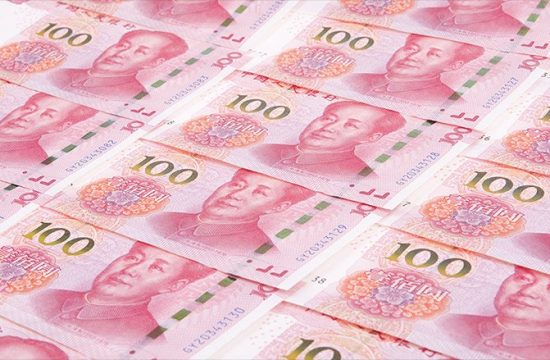
The yuan isn’t going to unseat the U.S. dollar anytime soon — but the Chinese currency’s rising prominence has been seen in global reserves as well as international trade.
Much has been said about the U.S. dollar losing its dominance as the world’s reserve currency, as it weakened sharply in recent weeks.
Still, analysts rejected the idea, saying there are no viable alternatives to the greenback at the moment. Its two closest competitors — the euro and the Chinese yuan — have their shortcomings, they said.
However, the Chinese yuan is set to gain more prominence, and indeed its global usage has gradually gone up owing to the country’s growing economic influence, analysts pointed out.
Factors such as the increasingly heated tech war between the U.S. and China, as well as Beijing’s growing influence by way of its Belt and Road initiative, are also crucial in the yuan’s reach for dominance, said Sven Schubert, senior investment strategist at Europe-based Vontobel Asset Management.
Push to internationalize the yuan gains traction
As China and the U.S. continue to tussle, tensions spilling over into the tech and financial spheres have “ignited a fresh push by Beijing to internationalize the RMB,” said Singapore-based bank DBS, referring to the Chinese currency’s other name, the renminbi.
The currency is now the sixth most used currency in international payments, and is used to settle about 20% of China’s trade, it said.
The Association of Southeast Asian Nations — made up of 10 countries in Southeast Asia — is also now China’s largest trading partner, which creates an opportunity to increase the yuan’s use in cross-border trade settlement, the bank said.
The share of the RMB in global reserves has also crept up — from 1% in 2016 to around 2% currently, according to data from the International Monetary Fund.
The Chinese currency has been strengthening in recent weeks too. The onshore yuan traded at its strongest level in nearly 16 months on Tuesday — at 6.8239 per dollar, according to Reuters. The offshore yuan was at 6.8236, a high since July 2019.
Belt and Road Initiative boost
China’s growing influence by way of its massive Belt and Road Initiative (BRI) is one factor which could lead to the yuan being used more commonly, Schubert said. The ambitious BRI project aims to build a complex network of rail, road and sea routes stretching from China to Central Asia, Africa and Europe. It is also aimed at boosting trade.
“Thanks to China’s Belt and Road Initiative, its influence in the Eurasian region and Africa is rising as it ties many countries to its economic system, which paves the way for the yuan to find its way more and more into global trade contracts,” he said.
Furthermore, China and Russia have teamed up to reduce their reliance on the U.S. dollar, Schubert said.
According to the latest annual report from the Bank of Russia, the country increased the share of the yuan in its reserves — from over 2% in 2018 to over 14% in 2019. It also reduced its share of U.S. dollars from around 30% to 9.7% in the same period.
That alliance has resulted in the greenback’s share in trade settlements between China and Russia falling below the 50% mark for the first time in the first quarter of 2020, according to Schubert. Overall, in the past five years, the dollar’s share in those trade settlements fell from 90% to 46%, he said.
“Measured in terms of economic importance, the Chinese currency is currently underrepresented. This is likely to change over time,” he said.
Around 50% of global trade contracts are still quoted in the U.S. dollar, despite the country accounting for only about 12% of global trade, Schubert said, citing an IMF study this year.
Beijing’s efforts to open up its financial sector, and its stock and bond markets being included in global indexes, should also gradually increase the yuan’s prominence, says Eswar Prasad, a trade professor at Cornell University.
Chinese A-shares, or shares that are traded on mainland indexes, were included in index provider MSCI’s global and regional indexes, while the bond market also got included in the Bloomberg Barclays index — all traded in yuan. As Chinese assets are increasingly traded in global markets, more foreigners will need to trade in the yuan, which is the intent of the internationalization drive.
Furthermore, China’s push for its new digital currency will also enhance the yuan’s role as an international payments currency, said Prasad, who was formerly the head of the International Monetary Fund’s China division.
“As China-U.S. tensions escalate, promoting the renminbi as an International currency could also help China to decouple from the U.S.,” he said. Still, he concluded that “for all its progress, the renminbi is unlikely to seriously rival the dollar as the dominant currency in global financial markets in the next few years.”
Tech war could ‘change the rules of the game’
Economic importance is not the only determining factor of whether a currency can hold sway, Schubert said, adding that the battle for technological supremacy is also key.
“While US withdrawal from key international organizations and treaties like the World Health Organization or the Paris Agreement has raised concerns over the US leaving a geopolitical vacuum that China is happy to fill, it is unlikely to threaten the USD’s dominance. The more important factor is the tech duel,” he said.
The tech war, he argues, “has the potential to change the rules of the game,” with digital supremacy “probably linked to military and geopolitical dominance.”
Washington has come down hard on Chinese tech companies recently — from sanctions on phone maker Huawei, to executive orders against short video-sharing app TikTok and messaging app WeChat.
The tech duel has also led to a splitting of the internet – the Chinese-focused internet versus the American-centric one, Schubert pointed out.
“A Chinese centric internet would argue for more Chinese influence in the Asian region as networks would be more closely linked to Chinese technology. This would even intensify the argument for Yuan usage in the region,” he added.


